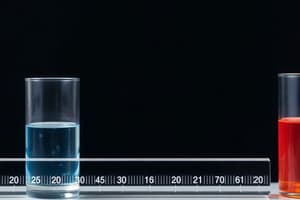Podcast
Questions and Answers
In a chemical reaction, what are the substances present before the reaction takes place called?
In a chemical reaction, what are the substances present before the reaction takes place called?
- Products
- Indicators
- Catalysts
- Reactants (correct)
Which type of reaction involves a single reactant breaking down into multiple products?
Which type of reaction involves a single reactant breaking down into multiple products?
- Chemical decomposition (correct)
- Single replacement
- Double replacement
- Chemical combination
Which of the following best describes a double replacement reaction?
Which of the following best describes a double replacement reaction?
- A single reactant breaks down into multiple products
- The positive and negative ions of two ionic compounds exchange resulting in two new compounds. (correct)
- An element replaces another element in a compound
- Multiple reactants combine to form a more complex product
In the reaction HCl + KOH → H₂O + KCl, what type of reaction is taking place?
In the reaction HCl + KOH → H₂O + KCl, what type of reaction is taking place?
What is the pH of a neutral solution?
What is the pH of a neutral solution?
A solution turns litmus paper blue. What does this indicate about the solution?
A solution turns litmus paper blue. What does this indicate about the solution?
Which of the following is an example of a chemical combination reaction?
Which of the following is an example of a chemical combination reaction?
What color will phenolphthalein turn in a basic solution?
What color will phenolphthalein turn in a basic solution?
What primarily distinguishes isotopes of the same element?
What primarily distinguishes isotopes of the same element?
Which of the following best describes the force holding atoms together in a molecule with a polar covalent bond?
Which of the following best describes the force holding atoms together in a molecule with a polar covalent bond?
If an atom gains an electron, what type of ion does it become?
If an atom gains an electron, what type of ion does it become?
Which of the following represents the correct relationship between atomic number and mass number?
Which of the following represents the correct relationship between atomic number and mass number?
What is the key difference between a covalent and ionic bond?
What is the key difference between a covalent and ionic bond?
Which of the following is a pure substance, composed of a single type of atom?
Which of the following is a pure substance, composed of a single type of atom?
A substance is characterized by a consistent chemical formula. Which type of substance does this definition best describe?
A substance is characterized by a consistent chemical formula. Which type of substance does this definition best describe?
What is the primary difference between a homogeneous and a heterogeneous mixture?
What is the primary difference between a homogeneous and a heterogeneous mixture?
Which separation technique is most appropriate for recovering salt from a saltwater solution?
Which separation technique is most appropriate for recovering salt from a saltwater solution?
A mixture contains a solid that is not dissolved, and a liquid. Which method would be most effective to initially separate the solid from the liquid?
A mixture contains a solid that is not dissolved, and a liquid. Which method would be most effective to initially separate the solid from the liquid?
In the reaction, $2Na + 2H_2O \rightarrow 2NaOH + H_2$, which substance is the reducing agent?
In the reaction, $2Na + 2H_2O \rightarrow 2NaOH + H_2$, which substance is the reducing agent?
Which process occurs at the cathode during electrolysis?
Which process occurs at the cathode during electrolysis?
A metal X is able to displace hydrogen from an acid. Based on the reactivity series, what can be concluded about metal X?
A metal X is able to displace hydrogen from an acid. Based on the reactivity series, what can be concluded about metal X?
What happens to an atom's oxidation number when it undergoes reduction?
What happens to an atom's oxidation number when it undergoes reduction?
In the reaction $Fe + CuSO_4 \rightarrow Cu + FeSO_4$, which substance is the oxidizing agent?
In the reaction $Fe + CuSO_4 \rightarrow Cu + FeSO_4$, which substance is the oxidizing agent?
Which of the following is NOT a characteristic of a redox reaction?
Which of the following is NOT a characteristic of a redox reaction?
During the electrolysis of a salt solution, which metals are preferentially deposited at the cathode?
During the electrolysis of a salt solution, which metals are preferentially deposited at the cathode?
Which of these substances would typically act as an oxidizing agent?
Which of these substances would typically act as an oxidizing agent?
What is the primary result of an ionic compound's dissociation in water?
What is the primary result of an ionic compound's dissociation in water?
When an acid ionizes in water, what is one of the key products formed, in addition to hydrogen ions?
When an acid ionizes in water, what is one of the key products formed, in addition to hydrogen ions?
What distinguishes the dissociation of hydroxides when they are placed in water?
What distinguishes the dissociation of hydroxides when they are placed in water?
What products are formed when salts dissociate in water?
What products are formed when salts dissociate in water?
What type of compound is aluminum chloride ($AlCl_3$)?
What type of compound is aluminum chloride ($AlCl_3$)?
What are 'oxoacids' primarily categorized as regarding their structure?
What are 'oxoacids' primarily categorized as regarding their structure?
What is a defining property of halogens?
What is a defining property of halogens?
How do halogens primarily occur in nature?
How do halogens primarily occur in nature?
Which halogen is a reddish-brown liquid at room temperature?
Which halogen is a reddish-brown liquid at room temperature?
Which of these is a common application of hydrochloric acid (HCl)?
Which of these is a common application of hydrochloric acid (HCl)?
What makes handling hydrogen fluoride (HF) particularly hazardous?
What makes handling hydrogen fluoride (HF) particularly hazardous?
What is the primary function of fluorides in dental care?
What is the primary function of fluorides in dental care?
Which of the following physical states is NOT associated with halogens as pure elements at room temperature?
Which of the following physical states is NOT associated with halogens as pure elements at room temperature?
Flashcards
Chemical combination
Chemical combination
A chemical reaction where multiple reactants combine to form a more complex product.
Chemical decomposition
Chemical decomposition
A chemical reaction where a single reactant breaks down into multiple products.
Single replacement
Single replacement
A chemical reaction where an element replaces another element in a compound to form a new element and a new compound.
Double replacement
Double replacement
Signup and view all the flashcards
Reactants
Reactants
Signup and view all the flashcards
Products
Products
Signup and view all the flashcards
Neutralization
Neutralization
Signup and view all the flashcards
pH
pH
Signup and view all the flashcards
What is an atom?
What is an atom?
Signup and view all the flashcards
What is a molecule?
What is a molecule?
Signup and view all the flashcards
What are protons?
What are protons?
Signup and view all the flashcards
What are electrons?
What are electrons?
Signup and view all the flashcards
What is the nucleus?
What is the nucleus?
Signup and view all the flashcards
What is a pure substance?
What is a pure substance?
Signup and view all the flashcards
What is an element?
What is an element?
Signup and view all the flashcards
What is a compound?
What is a compound?
Signup and view all the flashcards
What is a homogeneous mixture?
What is a homogeneous mixture?
Signup and view all the flashcards
What is a heterogeneous mixture?
What is a heterogeneous mixture?
Signup and view all the flashcards
Oxidation
Oxidation
Signup and view all the flashcards
Reduction
Reduction
Signup and view all the flashcards
Redox Reactions
Redox Reactions
Signup and view all the flashcards
Reducing Agents
Reducing Agents
Signup and view all the flashcards
Oxidizing Agents
Oxidizing Agents
Signup and view all the flashcards
Reactivity Series of Metals
Reactivity Series of Metals
Signup and view all the flashcards
Displacement Reaction
Displacement Reaction
Signup and view all the flashcards
Electrolysis
Electrolysis
Signup and view all the flashcards
Ionization
Ionization
Signup and view all the flashcards
What happens to acids in water?
What happens to acids in water?
Signup and view all the flashcards
Hydroxides in water
Hydroxides in water
Signup and view all the flashcards
What are salts?
What are salts?
Signup and view all the flashcards
Binary Compounds
Binary Compounds
Signup and view all the flashcards
Ternary Compounds
Ternary Compounds
Signup and view all the flashcards
Polyatomic Compounds
Polyatomic Compounds
Signup and view all the flashcards
What are Halogens?
What are Halogens?
Signup and view all the flashcards
Describe Chlorine (Cl)
Describe Chlorine (Cl)
Signup and view all the flashcards
Describe Bromine (Br)
Describe Bromine (Br)
Signup and view all the flashcards
Describe Iodine (I)
Describe Iodine (I)
Signup and view all the flashcards
What are halogen hydrides?
What are halogen hydrides?
Signup and view all the flashcards
Study Notes
Chemical Reactions
- Chemical reactions involve reactants transforming into products
- The number of atoms of each element must be conserved
- Reactants are substances that start the reaction
- Products are substances formed from reaction
- Chemical equations depict reactants and products
- Chemical formulas represent substances using element symbols and subscripts
- Types of chemical reactions include: combination, decomposition, single replacement, double replacement, acid-base neutralization, combustion
- Conservation of mass principle means mass of reactants equals mass of products
- Exothermic reactions release heat
- Endothermic reactions absorb heat
- Neutralization reactions involve acids and bases reacting to produce salt and water
- Examples of chemical reactions include:
- Combustion: Burning of a substance in the presence of oxygen (e.g., C + O₂ → CO₂)
- Neutralization: Acid + Base → Salt + Water (e.g., HCl + NaOH → NaCl + H₂O)
- Formation of a precipitate: Combining two soluble solutions to get an insoluble solid (e.g., AgNO₃ + NaCl → AgCl ↓ + NaNO₃)
pH and Indicators
- pH is a measure of acidity or basicity
- A pH value of 7 is neutral, below 7 is acidic, and above 7 is alkaline
- Indicators are substances that change color depending on pH
- Examples of indicators include litmus paper, phenolphthalein, universal indicator, and others
- Litmus paper turns red in acidic solutions and blue in basic solutions
- Phenolphthalein is colorless in acidic and neutral solutions, and pink or fuchsia in basic solutions
- Universal indicator shows a range of colors to represent different pH values
- pH can be measured using pH meters or indicators.
- Acids release H⁺ ions in water, while bases release OH⁻ ions.
- Acids have a sour taste; Bases have a bitter taste.
- pH scale ranges from 0 to 14
- Neutral solutions have a pH of 7
- Acidic solutions have a pH less than 7
- Basic solutions have a pH greater than 7
Studying That Suits You
Use AI to generate personalized quizzes and flashcards to suit your learning preferences.





